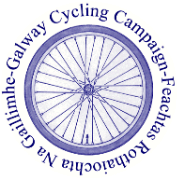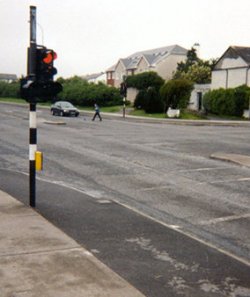
"Rules of the Road" a la Galway Corporation
Disclaimer: Nothing in this document is offered as a legal opinion if you are unsure as to the operation of the Road Traffic Regulations contact your legal advisor.
|
Road markings apparently directing cyclists to cycle on the right. (Left: Quincentenial Bridge, Right: Parkmore) |
|
|
Cycling or driving on the right is against the law [1] and is associated with massive increases in the risk of car/cycle collision. (Particularly when done by footpath/cycle path cyclists.) |
The example on the right is courtesy of Galway County Council and is slightly more benign since it is actually supposed to lead to an underpass. (This still leaves the issue of how one might safely or lawfully get onto the cycle path.) |
|
Another example of a sign directing cyclists to cycle against the normal flow of traffic. Note the car turning out of the junction in the background (blue arrow). According to Finnish research, cyclists who use paths to cycle the "wrong way" through this type of junction have a tenfold (x10) increase in the risk of being in collision with a car [2] . Galway corporation is known to have been aware of this issue for several months at the time this picture was taken. In the US the equivalent risk multipliers are (x4.5) [3] and in Sweden (x12) [4] . This section of road ends at the Terryland Roundabout, we have been unable to find collision data for cyclists who enter, or circulate, multilane roundabouts from the wrong direction. |
 |
|
 |
|
Newcastle Rd. (Adjacent to University) While the lights are green the exit/entry ramp is blocked by pedestrians. Once the lights go red the ramp clears so cyclists can proceed, provided they break the red light! When this road was built in the 1980's Galway corporation was apparently unable to find road design staff who were familiar with the rules of the road [5] . Despite repeated requests the GCC has been unable to obtain any satisfactory explanation from the authorities (National or Local) as to how cyclists might make lawful use of such a junction. |
||
|
A similar junction layout; This particular example was built in '98/99. Fifteen years on and apparently Galway corporation was still unable to find road design staff who were familiar with either the rules of the road or the available design guidance. According to Danish research, cycle paths have been identified as causing major safety problems at signalised intersections [6] while Swedish researchers have found that cycle path cyclists are 3-6 times more likely to break red lights [7] . In Galway this may have been the intent of the designers, (there are no detector loops on the cycle paths nor are there any push buttons provided for the cycle path users). Of particular note is the tanker, the general increase in collisions experienced by cycle-path users also applies to goods vehicles. According to a German study, cycle track users experience a two-fold increase in the risk of collision with goods vehicles. [8] A British study of cycling accidents found that 14/15 fatalities involving left turning vehicles were cyclist/goods vehicle collisions. [9] Goods/commercial vehicle collisions account for a quarter of cycling fatalities. Our Policy on Galway's Cycle Paths We have been unable to identify any means whereby a cyclist might reasonably be expected to make safe use of these structures at roundabouts, signalised intersections or side roads. The layout of these structures indicates that they cannot have been intended to increase either the safety or convenience of those road users who use bicycles. It is a firm conviction among many cyclists that these structures are actually intended to facilitate higher, and therefore in most cases both illegal and dangerous, driving speeds by motorised traffic. Since our formation we have been seeking either their modification or the outright removal of these devices from the roads in our city. Here is a web page with examples from Dublin: Dublin's cycle paths. Following the imposition of hostile, anti-cyclist, legislation by the Government [10] and in the absence of any action from Galway corporation we appealed to the Garda commissioner for the removal of all cycle lane markings from the roads in Galway city on grounds of traffic hazard. This brought the revelation that the road markings used by Galway corporation have no legal status. Apparently these devices are all legally footpaths or footways and cyclists (and motorists) are merely supposed to think that we are meant to use them. Disclaimer: Nothing in this document is offered as a legal opinion if you are unsure as to the operation of the Road Traffic Regulations contact your legal advisor. [1] Article 9. Save where otherwise required by these Regulations, a vehicle shall be driven on the left hand side of the roadway in such a manner so as to allow, without danger or inconvenience to traffic or pedestrians, approaching traffic to pass on the right and overtaking traffic to overtake on the right. (Traffic and Parking Regulations SI 182/97) [2] The Safety Effect of Sight Obstacles and Road Markings at Bicycle Crossings, M Rasanen and H. Summala, Traffic Engineering and Control, 1998. [3] Risk Factors for Bicycle-Motor Vehicle Collisions at Intersections., Wachtel A., and Lewiston D., Journal of the Institute of Transportation Engineers, September 1994, pp 30-35 [4] Russian Roulette turns Spotlight of Criticism on Cycleways, Velo Secure '90 conference, Salzburg 1990 [5] Article 30. (1) Where traffic sign number RTS 00I, RTS 002, RTS 003 or RTS 004 (referred to in these Regulations as traffic lights) is provided, a person shall not drive a vehicle past the traffic lights, or past traffic sign number RRM 017 [stop line] where such sign is provided in association with the traffic lights when the red lamp of the traffic light is illuminated. (Traffic and Parking Regulations SI 182/97) [6] Safety of cyclists in urban areas: Danish Experiences. Traffic Safety and Environment. Report 10. Danish Road Directorate. Copenhagen, 1994. (Cited in Safety of Vulnerable Road Users, OECD 1997) [7] Traffic safety evaluation of engineering measures -- Development of a method and its application to how physical lay-outs influence bicyclists at signalised intersections. Linderholm, L. Department of Traffic Planning and Engineering. LTH. Lund, 1992 (Cited in Safety of Vulnerable Road Users, OECD 1997) [8] Safety of Cyclists at Urban Junctions. Schnull R. and Alrutz D., R262 Bundesanstalt Fur StraBenwesen, 1993. [9] Cyclist road deaths in London 1985-1992: drivers, vehicles, manoeuvres and injuries. , McCarthy M, Gilbert K. Accident Analysis and Prevention, Mar;28(2):275-9, 1996 Abstract [10] Article 14 (3) (a) Subject to paragraph (b), a pedal cycle must be driven on a cycle track where one is provided.(Traffic and Parking Regulations SI 274/98)
|